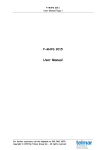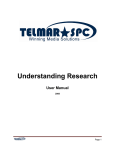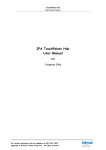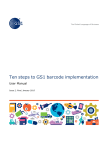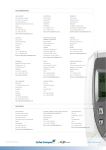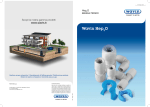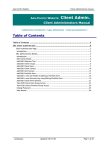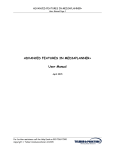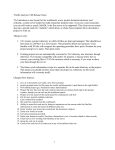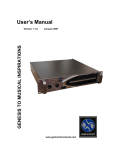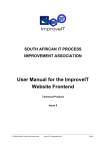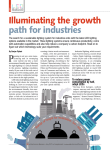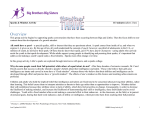Download Basic Coding - Telmar South Africa
Transcript
GUIDE TO BASIC CODING User Manual 2011 Page 1 Table of Contents Introduction .................................................................................................................................3 Where do we fit in? .....................................................................................................................4 Available Surveys .......................................................................................................................5 SAARF Surveys ......................................................................................................................5 AMPS ...................................................................................................................................5 RAMS ...................................................................................................................................6 TAMS ...................................................................................................................................7 Outdoor Research ................................................................................................................8 Some Surveys Conducted by Media Houses ...........................................................................9 Reader Retail Research .......................................................................................................9 Other Proprietary Owned Surveys ........................................................................................9 Understanding Data ..................................................................................................................10 Weightings ................................................................................................................................11 Population Weight .................................................................................................................11 Household Weight .................................................................................................................12 Household Decision Maker Weight ........................................................................................12 Household Purchaser Weight ................................................................................................12 Coding - Logical Operators .......................................................................................................13 The “And” Operator ...............................................................................................................14 The “Or” Operator ..................................................................................................................15 Combining Operators ............................................................................................................16 Priority ................................................................................................................................16 Margin of Error ..........................................................................................................................17 Page 2 Introduction Telmar is an international company, with offices in New York, London, Johannesburg , Amsterdam, Hong Kong, Canada, etc. Telmar was established in the United States in 1967 and was the pioneer in computer assisted media analysis. The South African offices were founded in 1982. All the major advertising agencies, media owners and media agencies make use of our systems. Telmar is a provider of software, capable of analyzing, processing and evaluating marketing and media data. Telmar does not collect the data and Telmar does not use the data itself, merely processes it into a format that is accessible by our software. The Telmar suite of programs encompasses various disciplines such as media planning and buying and media and marketing research. As Telmar is an international company many of the software packages used in South Africa are also used in other countries from New York to Israel and Amsterdam to Tokyo. In South Africa, Telmar is used by advertising agencies for media planning and as such, any media sales person using Telmar systems as a selling aid can be sure that the agency or advertiser will be using the same thing. There are a number of research surveys available to the South African Advertising industry. Some are funded by media houses and concentrate on researching data relevant to them. The main source of media information is AMPS, RAMS and TAMS. This data is funded by the industry from a 1% levy on advertising revenue. The research undertaken is decided on by the board and committees of SAARF on behalf of the industry. Currently the research is undertaken on SAARF’s behalf by ACNielsen who are the research contractor. Page 3 Where do we fit in? Page 4 Available Surveys SAARF Surveys AMPS All Media and Product Survey This survey looks at all South Africans over the age of 16 in rural & urban areas. In AMPS approximately 24,812 people are interviewed on a face-to-face basis. And in the 6month survey there are approximately 12,000 people interviewed. Each year the contents of the questionnaire changes slightly, some sections are rotated and some questions are deleted or added. This is done in order to shorten the questionnaire or take changes in SA, eg. Technological advances, into account. The survey includes: Demographic information such as age, income, gender, education, language, employment, area of residence, etc… Information on activities such as moved home, eaten in a restaurant, etc… Product information on a generic basis – purchasers of cheese, purchasers of sugar, etc. A questionnaire is left behind with the respondents for 7 days, where they fill in the amount of a product they either purchase or consume. It also looks at ownership of appliances, shopping habits, travel, etc… Media information on cinema, radio, television, magazines and newspapers – when listened to / viewed, how often read, etc… As of 2003, branded information for a variety of consumable was added to the survey. Page 5 RAMS Radio Audience Measurement Survey (Radio Diaries) This survey gives more radio audience details than SAARF AMPS®. SAARF AMPS® does not differentiate between Monday, Tuesday, etc audiences where as SAARF RAMS® records average audiences, separately for every day of the week. The same respondents used for SAARF AMPS® are used for SAARF RAMS®. The SAARF RAMS® Diary is left with the respondent at the end of the SAARF AMPS® interview and collected a week later. Respondents are expected to record their listening habits, for every station listened to, quarter hour by quarter hour, for 7 consecutive days. Respondents are also requested to, indicate their 3 most preferred stations (in order of preference). A new procedure called ‘flooding’ was introduced in 2004, where all household members, in addition to the one selected for SAARF AMPS are requested to keep a SAARF RAMS® Diary. This research methodology doubles the sample. Results are published every two months, six times a year and every reporting period covers the most recent two fieldwork periods on a rolling basis. Page 6 TAMS Television Audience Measurement Survey (Peoplemeters) SAARF TAMS Panel provides television viewing information, minute by minute, using ‘peoplemeters’. Peoplemeters are semi-automatic electronic equipment that is connected to 9 households’ television sets. It records TV viewing events automatically, while the members of the household are logging in and out by using a remote control. How the meters work The meters are units linked to television sets that register the set’s activity. Each person in the household, who is 4 years old or older, is allocated a button on a remote control that they press whenever they start or stop viewing. The demographic profile of each person is recorded when the household is first installed; allowing analyses to be done using various demographics as target markets. The meter phones the main computer each night to transfer the days viewing data. In places where there are no telephones, the computer uses a radio signal to transfer the data to a central collection point. Nielsen captures the viewing data each day and sends it to Telmar. Telmar processes the data, reducing it in size to a format that can be held on a PC. Telmar also runs rating for standard and non Standard target markets, maintains rate cards and programme details all of which are distributed with the data. This data is then made available to clients. At the request of two broadcasters, SAARF is considering the measurement of 4-7 year old children. Page 7 Outdoor Research The Nielsen Personal Outdoor Device (Npod) was used to accurately track respondent travel patterns by capturing the traveling co-ordinates. The Npod strengths include: More advanced chip set than commercial units for greater sensitivity Size of a standard cellphone for ease of carrying Sufficient memory to allow collection every few seconds over 9 days Accurate measurement of location, time, speed and direction of travel The national readership and radio surveys provided the placement interview for Outdoor. At the end of the placement interview, respondents were asked to carry an Npod for 9 days. The Npod was then collected with the Radio Diary and self-completion questionnaires Participants were asked to fill in a short daily travel log to be collected at the same time When travelling in a vehicle, the Npod needed to be placed on the dashboard or at the back window to ensure satellite reception, but this caused a problem as South Africa has a high incidence of theft from vehicles. In order to get past this problem, Nielsen decided to introduce the Elipod which is simply, placing the Npod into a stuff Elephant toy. The Outdoor media owners supplied all their site information (GPS co-ordinates) in an electronic database which is then matched with the co-ordinates from the Npod to produce OTS information Page 8 Some Surveys Conducted by Media Houses Reader Retail Research This survey is commissioned by Independent Newspapers. Its primary focus is on the readership of the local free publications which are not measured on AMPS as well as their other newspapers. It also looks in depth at which shopping centres people are using. It is designed to attract retail advertising. Other Proprietary Owned Surveys FutureFact – This study enables users to understand the underlying mindsets, trends, and values of South African. Bratrax – This study provides an in-depth understanding of the market segment 6 to 17 years of age. African Surveys – AMPS and diary surveys for Kenya, Ghana, Tanzania, Uganda and Zimbabwe, Zambia, Malawi, Nigeria SABRE – This study provides an in-depth understanding of the business market. (Johnnic) Compass24 – This study provides an in-depth understanding of the community papers (ADS24) ROOTS - This study provides an in-depth understanding of the community papers (Caxton) Page 9 Understanding Data The first step towards understanding coding is understanding data. What it is, how it is stored, and what the computer does to retrieve the information you request. Here are the steps in order to get the final results we use: Face to Face Interviews are done Completion of questionnaires via CAPI System Selected sample of people interviewed. They represent the total population Multi Response: List of possible answers is presented eg. How many people in your household earn money? Single Response: Answer is either POSITIVE or NEGATIVE eg. Do you own a car? Yes or No Nielsen reworks / tests the data before releasing to Software Companies Software companies release data to the industry. (Tape Layouts are supplied to companies) Tape Layout: In order to know what information is available, you will need to refer to the tape layout that contains all the respondents’ answers to the actual questionnaire. This form the major part of the type layout. Each layout has an index, a recommended weight selection page. Page 10 Weightings The way that questions are asked will affect the weights used. In general there are four weights: Population Household Household Decision Maker Household Purchaser Population Weight This weight is used for questions that are directed at the individual in the household. For example: How old are you? What car do you drive? Have you read Bona in the past 6 months? Have you personally tried to lose weight by using slimming preparations in the past 12 months? Page 11 Household Weight One person or a group of persons, usually but not always members of one family, who live together and whose expenditure on food and other household items is jointly managed. Boarders or lodgers may be included as members of a household provided that they have at least one main meal a day communally. Resident domestic servants are excluded and regarded as forming a household of one or more persons in their own right. The weight is used for questions that refer to the household and is used with regard to certain products such as “having a stove in the home.” Household weights can only be used on the following demographics: Household Income Geographical Location Living Standards Measures A household, due to it being all members living in that home, cannot have an age, sex or read any particular magazine or watch a particular TV station. Household Decision Maker Weight If the analysis is to be done to establish media usage or other personal demographics for ”household” questions then the Household Decision Maker Weight should be use after filtering on the HH Decision Maker (Male Head of Household or Female Housewife) Example: If one needs to find out “People with a Household Income who lives in Gauteng” The wording of the question and the purpose of the analysis determines whether analysis by Household Decision Maker Weight is meaningful. Household Purchaser Weight Any respondent of either sex who claims to be solely or partly responsible for the household purchases. These respondents weighted to households, form the basis of the values relating to household FMCG categories. Page 12 Coding - Logical Operators Up until now, the sample coding statements have consisted of a single code. This will often be sufficient, but the software becomes most useful when joining codes to establish characteristics of target markets. For example, you might want to know not only how many people drink tea, but how many of them are men, how many of them are women, how many of the men are within a certain age group. The operators used to join codes or mnemonics are: AND OR ( ) Example The common rule is, if you have more than one thing from a group, you have to use the “OR” and between groups, you would use the “AND”. If there is more than one thing that you need to code within a group, you have to combine them together by using brackets. No brackets are needed when you only use one code from a group. Page 13 The “And” Operator The “AND” operator tells the software that both answers must have POSITIVE responses recorded eg. Females, who reads the Cosmopolitan. Female AND Cosmopolitan o FEMCOSM (The or the AND is used to join the mnemonics) The software would then only count females who said they read the Cosmopolitan. The “AND” operator can be used to join a number of mnemonics eg. Females, Age 16–24, who read the Cosmopolitan and live in Johannesburg. Female AND Age 16-24 AND Cosmopolitan AND Johannesburg In the definition “AND” they must be both one thing and the other, i.e. getting smaller. In the “AND”, one universe falls within another, i.e. beauty conscious within married females. The result can never be larger than the smallest of the two. Page 14 The “Or” Operator The “OR” operator tells the software that the result is POSITIVE if either or both of the recorded responses is POSITIVE eg. People who read the Femina or the Cosmopolitan Femina OR Cosmopolitan o FEM, COSM (The, or the OR is used to join the mnemonics) The computer would then count all people who said they read the Femina or the Cosmopolitan or both the Cosmopolitan and the Femina. “OR” says they may be two things, either one or the other, getting bigger. With “OR” the computer takes both universes with the result and is never smaller that the largest of the two. Page 15 Combining Operators Priority The software has a strict order or priority when using more that one operator i.e. using both the “AND” and the “OR” operators eg. Females between 16 and 34. Female AND (Age 16-24 OR Age 25-34) (The and the brackets are used in this coding expression) The order of priority is firstly, BRACKETS (). In the absence of BRACKETS, the order of priority is, firstly the “AND” then the “OR”. Brackets should always be present when more than one operator is being used. Page 16 Margin of Error Deviation from the true figure. In researching, when sampling is used, the population is subject to sampling errors. The smaller the sample, the larger will be the margin of error. A 95% confidence level is used – it means that if 100 similar samples are used, the error would for 95 of them be within the relevant margin, whilst 5 could fall outside this figure S = p x (100-p) x 1.96 n Where: S = Standard Error p = Penetration (% who viewed) n = Sample Size Page 17

















